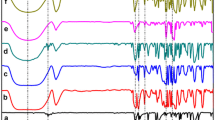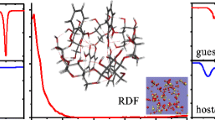Abstract
Calorimetry, densimetry, 1H NMR and UV–vis spectroscopy were used to characterize inclusion complex formation of hydroxypropylated α- and β-cyclodextrins with meta- and para-aminobenzoic acids in aqueous solutions at 298.15 K. Formation of more stable inclusion complexes between para-aminobenzoic acid and cyclodextrins was observed. The binding of aminobenzoic acids with hydroxypropyl-α-cyclodextrin was found to be enthalpy-governed owing to the prevalence of van der Waals interactions and possible H-binding. Complex formation of hydroxypropyl-β-cyclodextrin with both acids is mainly entropy driven. The increased entropy contribution observed in this case is determined by dehydration of solutes occurring during the revealed deeper insertion of aminobenzoic acids into the cavity of hydroxypropyl-β-cyclodextrin. By comparing complex formation of aminobenzoic acids with native and substituted cyclodextrins it was found that the availability of hydroxypropyl groups slightly influenced the thermodynamic parameters and did not change the binding mode or driving forces of interaction.








Similar content being viewed by others
References
Loftsson T, Duchêne D. Cyclodextrins and their pharmaceutical applications. Int J Pharm. 2007;329:1–11.
De Lisi R, Lazzara G. Aggregation in aqueous media of tri-block copolymers tuned by the molecular selectivity of cyclodextrins. Therm Anal Calorim. 2009;97:797–803.
Novăk Cs, Éhen Z, Fodor M, Jiesinszky L, Orgoványi J. Application of combined thermoanalytical techniques in the investigation of cyclodextrin inclusion complexes. J Therm Anal Calorim. 2006;84:693–701.
Terekhova IV, Kumeev RS, Alper GA. Inclusion complex formation of α- and β-cyclodextrins with aminobenzoic acids in aqueous solution studied by 1H NMR. J Incl Phenom Macrocycl Chem. 2007;59:301–6.
Terekhova IV, Obukhova NA. Study on inclusion complex formation of m-aminobenzoic acid with native and substituted β-cyclodextrins. J Solut Chem. 2007;36:1167–76.
Terekhova IV. Volumetric and calorimetric study on complex formation of cyclodextrins with aminobenzoic acids. Mend Commun. 2009;19:110–2.
Shuang S, Yang Y, Pan J. Study on molecular recognition of para-aminobenzoic acid species by α-, β- and hydroxypropyl-β-cyclodextrin. Anal Chim Acta. 2002;458:305–10.
Yang Y, Shuang S-M, Chao J-B, Zhang G-M, Ding H-Y, Dong C. Study on the molecular recognition interaction of β-cyclodextrin with aminobenzoic acid isomer. Acta Chim Sin. 2004;62:176–82.
Setniča V, Urbanová M, Král V, Volka K. Interactions of cyclodextrins with aromatic compounds studied by vibrational circular dichroism spectroscopy. Spectrochim Acta A. 2002;58:2983–9.
Harata K. Induced circular dichroism of cycloamylose complexes with meta- and para-disubstituted benzenes. Bioorg Chem. 1981;10:255–65.
Tanaka M, Kawaguchi Y, Nakae M, Mizobuchi Y, Shono T. Separation of disubstituted benzene isomers on chemically bonded cyclodextrin stationary phases. J Chromatogr A. 1982;246:207–14.
Lewis EA, Hansen LD. Thermodynamics of binding of guest molecules to α- and β-cyclodextrins. J Chem Soc Perkin Trans. 1973;2:2081–85.
Stalin T, Rajendiran N. Intramolecular charge transfer effects on 3-aminobenzoic acid. Chem Phys. 2006;322:311–22.
Stalin T, Shanthi B, Vasantha Rani P, Rajendiran N. Solvatochromism, prototropism and complexation of p-aminobenzoic acid. J Incl Phenom Macrocycl Chem. 2006;55:21–9.
Stalin T, Rajendiran N. Intramolecular charge transfer associated with hydrogen bonding effects on 2-aminobenzoic acid. J Photochem Photobiol A. 2006;182:137–50.
Zhang Y, Sh Yu, Bao F. Crystal structure of cyclomaltoheptaose (β-cyclodextrin) complexes with p-aminobenzoic acid and o-aminobenzoic acid. Carbohydr Res. 2008;343:2504–8.
Picker P, Tremblay E. A high-precision digital readout flow densimeter for liquids. J Solut Chem. 1974;3:377–84.
Christensen JJ, Wrathall DP, Izatt RM, Tolman DO. Thermodynamics of proton dissociation in dilute aqueous solution. IX. pK, ΔH 0, and ΔS 0 values for proton ionization from o-, m-, and p-aminobenzoic acids and their methyl esters at 25. J Phys Chem. 1967;71:3001–6.
Gelb RI, Schwartz LM, Bradshaw JJ, Laufer DA. Acid dissociation of cyclohexaamylose and cycloheptaamylose. Bioorg Chem. 1980;9:299–304.
Liu L, Guo Q-X. The driving forces in the inclusion complexation of cyclodextrins. J Incl Phenom Macrocycl Chem. 2002;42:1–14.
He Y, Wu C, Kong WJ. A theoretical and experimental study of water complexes of m-aminobenzoic acid mABA·(H2O) n (n = 1 and 2). J Phys Chem A. 2005;109:748–53.
Simova S, Schneider H.-J. NMR analyses of cyclodextrin complexes with substituted benzoic acids and benzoate anions. J Chem Soc Perkin Trans. 2000;2:1717–22.
Terekhova IV, De Lisi R, Lazzara G, Milioto S, Muratore N. Volume and heat capacity studies to evidence interactions between cyclodextrins and nicotinic acid in water. J Therm Anal Calorim. 2008;92:285–90.
De Lisi R, Milioto S, Pellerito A, Inglese A. Thermodynamic properties of sodium n-alkanecarboxylates in water and in water + cyclodextrin mixtures. Langmuir. 1998;14:6045–53.
Wilson LD, Verrall RE. A volumetric study of β-cyclodextrin/hydrocarbon and β-cyclodextrin/fluorocarbon surfactant inclusion complexes in aqueous solution. J Phys Chem. 1997;101:9270–7.
Spildo K, Høiland H. Complex formation between alkane-α,ω-diols and cyclodextrins studied by partial molar volume and compressibility measurements. J Solut Chem. 2002;31:149–64.
Friedman HL, Krishnan CV. In: Franks F, editor. Water, a comprehensive treatise, vol. 3, chap. 1. New York: Plenum Press; 1973.
Manor PC, Saenger W. Topography of cyclodextrin inclusion complexes. III Crystal and molecular structure of cyclohexaamylose hexahydrate, the water dimmer inclusion complex. J Am Chem Soc. 1974;96:3630–9.
Lindner K, Saenger W. β-Cyclodextrin-dodecahydrat: haufung von wassermolekulen in einer hydrophoben huhlund. Angew Chem. 1978;90:738–40.
Fukahori T, Kondo M, Nishikawa S. Dynamic study of interaction between β-cyclodextrin and aspirin by the ultrasonic relaxation method. J Phys Chem B. 2006;110:4487–91.
González-Gaitano G, Crespo A, Compostizo A, Tardajos G. Study at a molecular level of the transfer process of a cationic surfactant from water to β-cyclodextrin. J Phys Chem B. 1997;101:4413–21.
Kondo M, Nishikawa S. Inclusion kinetics of a nucleotide into a cyclodextrin cavity by means of ultrasonic relaxation. J Phys Chem B. 2007;111:13451–4.
Acknowledgements
We are grateful to M. Koźbiał and H. Szczogryn from the Institute of Physical Chemistry of PAS for their help with calorimetric measurements.
Author information
Authors and Affiliations
Corresponding author
Rights and permissions
About this article
Cite this article
Zielenkiewicz, W., Terekhova, I.V., Wszelaka-Rylik, M. et al. Thermodynamics of inclusion complex formation of hydroxypropylated α- and β-cyclodextrins with aminobenzoic acids in water. J Therm Anal Calorim 101, 15–23 (2010). https://doi.org/10.1007/s10973-010-0797-6
Published:
Issue Date:
DOI: https://doi.org/10.1007/s10973-010-0797-6




